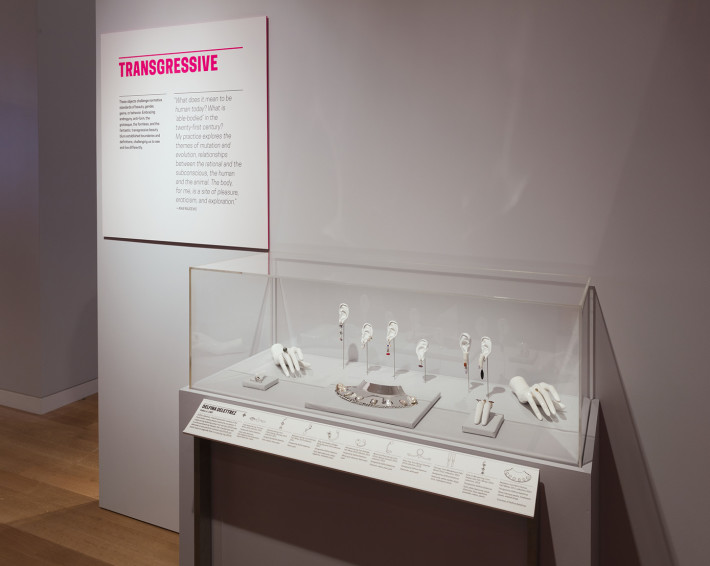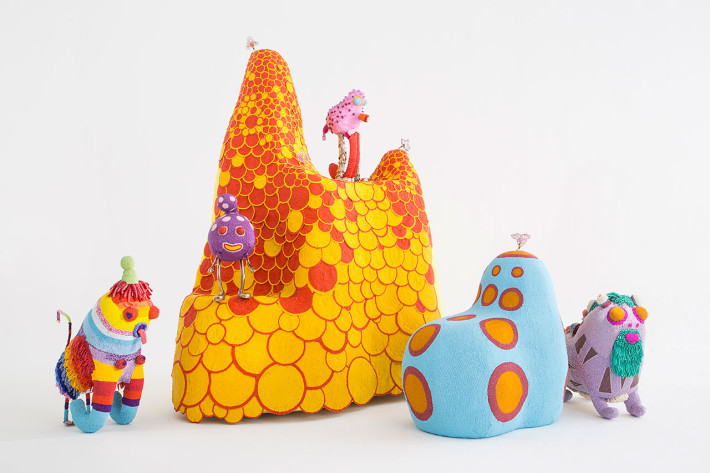15 July 2016
“Beauty will save the world,” says Prince Myshkin in Dostoevsky’s The Idiot. It is on this prophecy that the exhibition Beauty—Cooper Hewitt Design Triennial, curated by Andrea Lipps and Ellen Lupton and held at the Cooper Hewitt, Smithsonian Design Museum in New York until August 21 seems to be a reflection. The intent is a highly ambitious one: to present an exhaustive panorama of the new meanings of beauty by putting on show the works of over sixty artists, product designers, fashion designers and researchers. The investigation focuses on the transformative power of aesthetic innovation and on what the word “beautiful” really means nowadays. Organized along a route that runs through two floors, the exhibition is divided into seven sections: extravagant, intricate, ethereal, transgressive, emergent, elemental and transformative. The format is multidisciplinary and embraces all forms of creativity, even including biology. Among the masters of extravagance is Giambattista Valli, with his dresses as fluffy as clouds, along with the hair artist Guido Palau, able to create styles at the very limits of the possible. Those who tackle the “intricate” aspect of the theme include the fashion designer Mary Katrantzou, known for her research into texture, and the Dutch Studio Job, with its ironic and irreverent objects. One of the exponents of the “ethereal” is the perfume expert Sissel Tolaas, charged with formulating a special fragrance dedicated to Central Park, while among the “transgressives” we find Ana Rajcevic, who raises questions about the boundaries between humanity and the animal world with her zoomorphic headgear. Analysis of the relationship between human evolution and the transformation of aesthetic parameters is increasingly evident in the designs of Alexandra Daisy Ginsberg and Neri Oxman, both included in the “emergent” section: in her work Designing for the Sixth Extinction, the former imagines genetically modified creatures that clean toxins from the air; the latter uses 3D printers to create wearable objects that house microorganisms. In the “elementary” section we find Formafantasma, masters in the use of the raw materials provided by nature, while in the “transformative” one it is the Icelander Brynjar Sigurðarson who stands out, taking traditional fishing materials and techniques and turning them into tables and decorative sculptures. The link binding this heterogeneous exhibition together is design, understood in its broadest sense, as a gigantic container into which the different forms of art can be fitted. In this sense, therefore, it does suggest what the essence of beauty is today: its ability to let itself be contaminated and to react to the mutability of the world. And even if beauty is not going to save it, it will certainly help make it a more pleasant place.
Beauty—Cooper Hewitt Design Triennial
Curated by Andrea Lipps and Ellen Lupton
Cooper Hewitt, Smithsonian Design Museum, New York
February 12-August 21

Installation view of “Beauty—Cooper Hewitt Design Triennial.” Photo: Matt Flynn. © 2016 Cooper Hewitt, Smithsonian Design Museum.

Installation view of “Beauty—Cooper Hewitt Design Triennial.” Photo: Matt Flynn. © 2016 Cooper Hewitt, Smithsonian Design Museum.

Installation view of “Beauty—Cooper Hewitt Design Triennial.” Photo: Matt Flynn. © 2016 Cooper Hewitt, Smithsonian Design Museum.

Installation view of “Beauty—Cooper Hewitt Design Triennial.” Photo: Matt Flynn. © 2016 Cooper Hewitt, Smithsonian Design Museum.

Installation view of “Beauty—Cooper Hewitt Design Triennial.” Photo: Matt Flynn. © 2016 Cooper Hewitt, Smithsonian Design Museum.

Installation view of “Beauty—Cooper Hewitt Design Triennial.” Photo: Matt Flynn. © 2016 Cooper Hewitt, Smithsonian Design Museum.

Installation view of “Beauty—Cooper Hewitt Design Triennial.” Photo: Matt Flynn. © 2016 Cooper Hewitt, Smithsonian Design Museum.

Installation view of “Beauty—Cooper Hewitt Design Triennial.” Photo: Matt Flynn. © 2016 Cooper Hewitt, Smithsonian Design Museum.

Installation view of “Beauty—Cooper Hewitt Design Triennial.” Photo: Matt Flynn. © 2016 Cooper Hewitt, Smithsonian Design Museum.

The Haas Brothers (Nikolai Haas and Simon Haas) with The Haas Sisters of Monkeybiz, Al-Gorilla, Eye-sik Newton, Neil Tongue, Bill Nyeland, Isle Be Back, and Fungulliver, from the Afreaks series, 2015. Monkeybiz is a nonprofit income-generating bead project founded in 2000.

Vlisco, design by Francesca Franceschi; Textile, 5246/RW/3 Java, from the Think collection, 2015. © Vlisco Netherlands B.V.

Melitta Baumeister, Jacket (detail), from Fall / Winter 2014. Ready-to-Wear collection, 2014. Neoprene. Featured in book; alternate object will appear in exhibition.

Hair styled by Guido Palau; Photographed by Fabien Baron; 2011. Featured in book; new work will be presented in exhibition.

Dokter and Misses (Adriaan Hugo and Katy Taplin), Horseman bench, from Kassena Town series, 2015. Courtesy: Dokter and Misses.

TheUnseen, Lauren Bowker, Jacket, from the AIR collection, 2014. Courtesy: Jonny Lee Photography. © TheUnseen.

Maiko Takeda, Atmospheric Reentry series, 2013–14. Courtesy: © Bryan Huynh.

Brunno Jahara, Fruit bowl, from Multiplastica Domestica collection, 2012. Copyright: © Jahara Studio.

Hemmerle, Earrings, 2013. Courtesy: Cooper Hewitt.

Formafantasma: Andrea Trimarchi and Simone Farresin for Gallery Libby Sellers, Iddu mirror, from De Natura Fossilium collection, 2014, Obsidian mirror, lava rock, brass. © Studio FormaFantasma.

Jean Yu, Undergarment, 2015. Courtesy: Cooper Hewitt.